Summer Update 3: Passionflowers and Butterflies
It’s been an exceptionally good season. We had a warm, mild spring, followed by an unusually wet summer – so everything is green and lush!
I’ve been a fan of passionflowers for a long time. I have begun seriously collecting the hardy varieties, focusing on flowers and fruit. Many of the new hybrids are cold-hardy for our Zone 8a garden, and the plants that I put in the ground last year and year before last, are really kicking in.
The biggest vine in the yard is Passiflora “Incense” – it is the first one I planted, and it has really thrived. Sadly, it doesn’t make fruit – but it sets usually 30 to 50 of these flowers every day. They’re usually between 3″ and 4″ across.
You can see how vigorous the vine is – it’s this solid across about fifteen feet of fence.
P. “Constance Elliott” is a color sport of P. caerulea; it is exceptionally hardy, and also has a sweet fragrance, especially in the evenings. I love the water on the petals – it’s something that this species just does. Except for the driest, hottest days, these flowers look like they’ve been freshly dew-kissed. The buds actually drop water if you bump them. Tennyson wrote in Maud, “There has fallen a splendid tear / From the passion-flower by the gate.” I like the idea of splendid tears.
This is P. caerulea, the species. The plant is doing OK, but not as well as the Constance Elliott – I think that the location doesn’t allow it quite as much enriched soil to dig in to. I’ve put alpaca manure on it, which has helped a lot. Sadly, the fruit is fairly insipid – it tastes almost more like a vegetable than a fruit.
P. incarnata, the native species, is my favorite for fruit. You can read here about foraging them on the freeway verge, and making jelly.
We had some surprise seedlings – I didn’t realize that Chris had re-used some peat pots I had (unsuccessfully) tried planting passionflower seeds in. When he planted tomato seeds and put them on the heat mat, the heat caused the passionflower to germinate. These flowers are from the sprouts from this spring! He made these bamboo and string trellises for them. So far, haven’t gotten any fruit, but they’re working on it.
Along the lines of fruits and flowers – I’m also growing some new hybrids. This is P. “Temptation X Temptation.” It’s a tetraploid – which means that it has been manipulated to have double the number of genes. This tends to yield very vigorous plants. I’m hoping that they prove cold-hardy here; we’re on the edge of their zone tolerance.
This delicate and beautiful white flower is from P. “Bill’s Delight” – which I got by mail-order, and was doing really well until it just turned brown in the stem and died from the base upward. I don’t know what got to it. I’ll probably get another one this fall, and try it again; the flower is really lovely. There are other white P. incarnata sports that are supposed to have more fruit (this one has more flowers, fewer fruits) and I’ll probably try one of those as well.
Currently, in the yard I have: Passiflora incarnata, Passiflora “Incense,” Passiflora caerulea, Passiflora “Constance Elliott,” Passiflora belotii (=alatocaerulea), Passiflora lutea, Passiflora “Amethyst,” Passiflora “Bucky,” Passiflora “Temptation x Temptation,” Passiflora “Clear Sky,” and one hybrid that I’m not sure of the name, and I’m waiting for flowers to get help with an ID.
With passionflowers, we always get plenty of these – this is the chrysalis of a Gulf Fritillary, Agraulis vanillae. Unfortunately, I have to use some organic insect spray against them to keep them from totally stripping the vines. They can have any on the back of the fence, and I have the ones on the front of the fence.
Gulf Fritillary on the lantana. This shot is from last fall, but we’ve had lots this summer as well.
This Giant Swallowtail, Papilio cresphontes, really loves the lantana. It doesn’t sit still very well, though! Every picture of it was blurred somewhere.
With all the rain, the basil is doing great, we’ve got lots of squash and tomatoes… but also lots of bermuda grass and weeds. It’s just too hot to spend much time weeding.

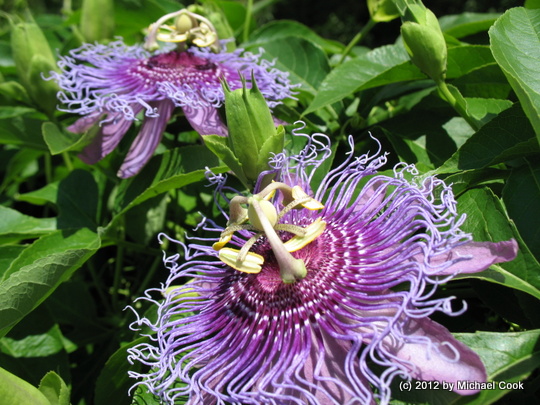
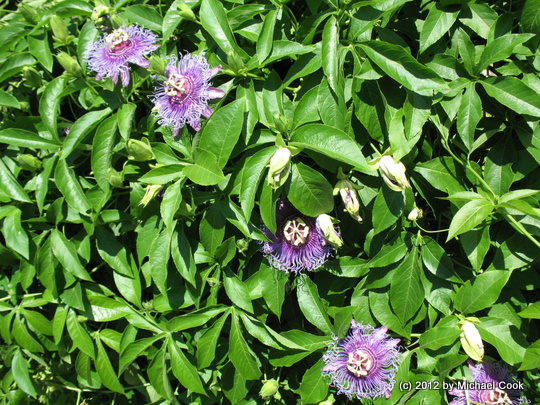
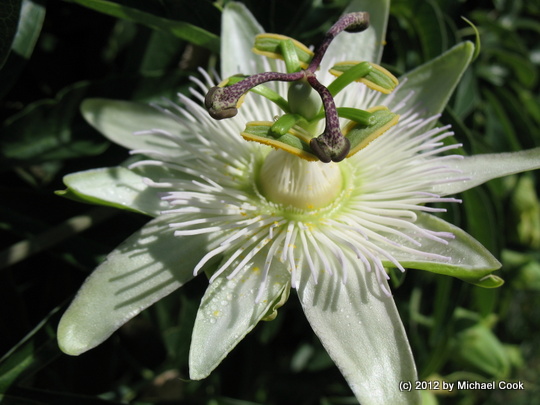
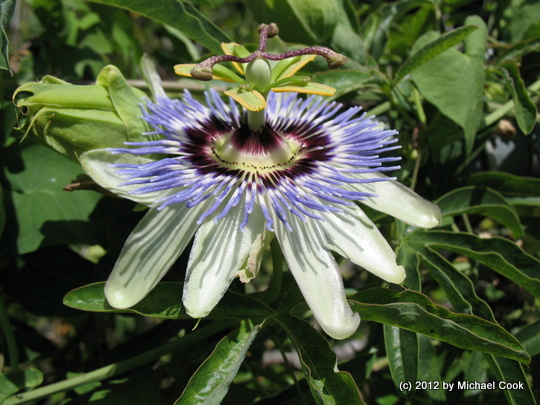
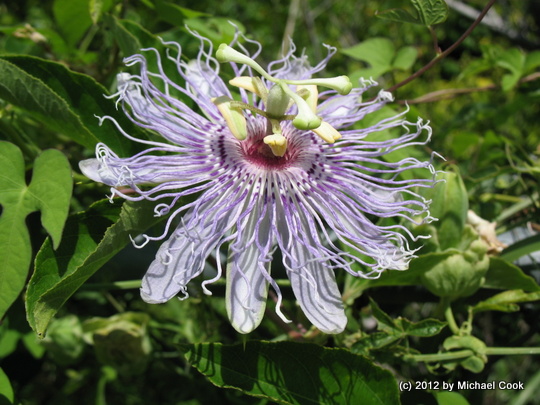

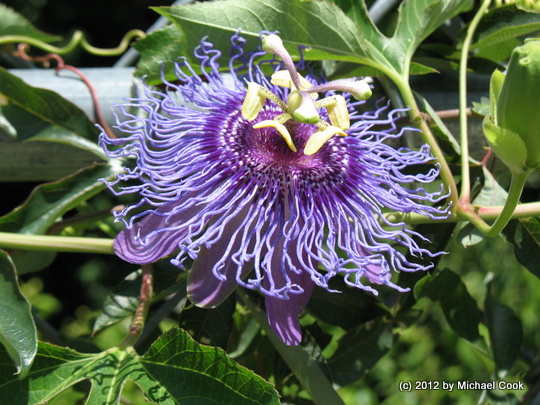

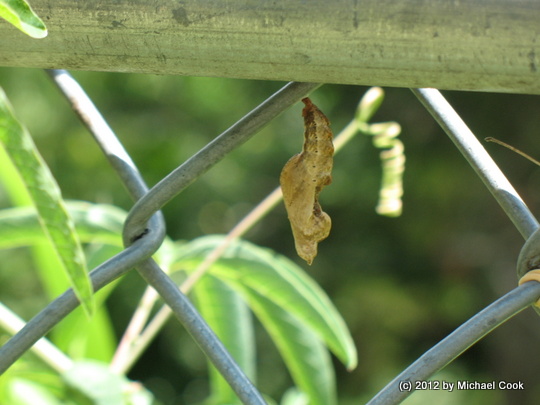

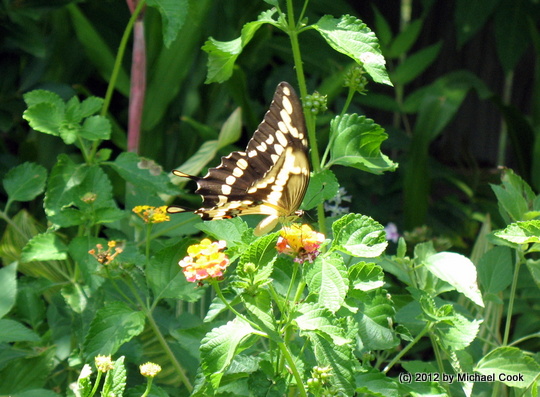
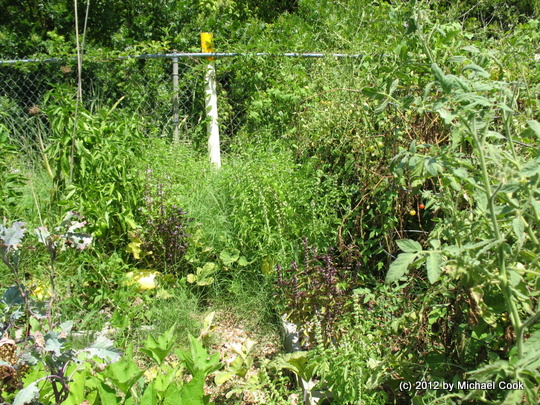
thanks for the garden update and all the passion flower info. thats one thing i have never put in here. you make me want to add one. i used to enjoy one in the yard of a house i rented years ago. they grow very easily here.
I loved growing up with passionfruit in Australia (in the Sydney area) and would love to grow one here in Plano, (just north of Dallas, TX) but really am more interested in getting the best fruit. What would you recommend? I prefer the purple colored fruit but have seen yellow ones as well. Is there any difference tastewise between the two? I would love something that won’t take over the yard and would consider growing in a large pot so that I could get the best sun as much of my yard is now shaded due to neighbors large trees on both sides of my property.Appreciate your input.
Lisa, both of those (yellow-skin type and purple-skin type) are P. edulis cultivars – they will grow here during the warm months, but they won’t survive our winters. You can occasionally find them at local nurseries, but not often – you’d have better luck ordering from an online greenhouse supplier. The best fruit for here in Dallas is P. incarnata, the wild type – and you can find that at a number of online retailers, sometimes you’ll find it at nurseries, and you can find it on the hillsides around Dallas! I pick from several patches; you can visit the patch with a shovel, and get a bunch of little plant starts. They WILL spread… they runner like mint… so just be aware of that, and a pot would keep them contained but also may limit fruiting because the roots won’t have enough space to draw from.